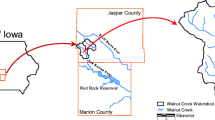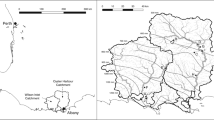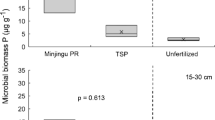Abstract
Two surfaces soils with contrasting physical and chemical characteristics were placed in model ponds to provide a sediment phosphate (P) source. Water samples were obtained weekly or biweekly and analyzed for total, total soluble, and soluble reactive P. Fertilizer P additions which exceeded sediment P absorption capacity occasionally tended to produce significantly higher P concentrations. Smaller P additions had no influence on pond P concentrations and no relationship between pond P concentrations and sediment EPC values was found. Soluble reactive P concentrations in most of the ponds were similar and seldom > 5 µg/1.
Two mechanisms significantly affected P transport from the sediments. The first were macrophytic plants which provided a large P sink in the water column. The second was fixation of readily soluble P within the sediments. Plant growth within the ponds used < 5% of the readily soluble P initially present. Diffusion of P from the sediments did not support large SRP concentrations within the ponds.
Similar content being viewed by others
References
Chiou, C-J & Boyd, C. E. 1974. The utilization of phosphorus by the phytoplankton, Scenedesmus dimorphus and the significance these findings to the practice of pond fertilization. Hydrobiologia 45: 345–355.
Fitzgerald, G. P. 1971. Nutrient sources for algae and their control. Water Resources Ctr., Univ. of Wisconsin, Wisc. EPA-Proj #16010 EHR / Aug 71.
Golterman, H. L., Bakels, C. C. & Jakobs-Mögelin, J. 1970. Availability of mud phosphates for the growth of algae. Verh. Internat. Verein. Limnol. 17: 467–479.
Golterman, H. L. & Clymo, R. S. 1969. Methods for chemical analysis of fresh waters. Int. Biol. Programme. Blackwell Scientific Publ., Oxford, England. 166 p.
Harter, R. D. 1968. Adsorption of phosphorus by lake sediment. Soil Sci. Soc. Amer. Proc. 32: 514–518.
Hynes, H. B. N. & Greib, B. J. 1970. Movement of phosphate and other ions from and through lake muds. J. Fisheries Res. Board Can. 27: (nu4) 653–668.
Kamp-Nielsen, Lars. 1974. Mud-water exchange of phosphate and other ions in undisturbed sediment cores and factors affecting the exchange rates. Archiv. Für. Hydrobiol. 73: 218–327.
Ku, W. C. & Foess, G. W. 1973. Aquatic sediments. J. Water Pollut. 45: 1301–1310.
MacPherson, L. B., Sinclair, N. R. & Hayes, F. R. 1958. Lake water and sediment. III. The effect of pH on the partition of inorganic phosphate between water and oxidized mud or its ash. Limnol. and Ocean. 3: 318–326.
Martin, J. H. & Leonard, W. H. 1964. Principles of field crop production. MacMillan Company, New York, NY. 1176 p.
Mortimer, C. H. 1941. The exchange of dissolved substances between mud and water in lakes. J. Ecology. 29: 280–329.
Norvell, W. A. 1974. Insolubilization of inorganic phosphate by anoxic lake sediment. Soil Sci. Soc. of Amer. Proc. 38: 441–445.
Olness, Alan, Troeger, W. W., Pardue, G. D. & Huckleberry, R. R. (1978). Phosphorus in a model pond study: I. Sediment selection and preparation. Hydrobiologia 63: 11–15.
Patrick, W. H., DeLune, R. D. & Antie, D. A. 1974. Transformation of added phosphate in flooded soil. Tr. Meghdunar. Kongr. Pochvoved., 10th 4: 296–304.
Patrick, W. H. & Khalid, R. A. 1974. Phosphate release and sorption by soils and sediments: Effect of aerobic and anaerobic conditions. Science 186: 53–55.
Porcella, D. B., Kumagai, J. S. & Middlebrooks, E. J. 1970. Biological effects on sediment-water nutrient interchanged.J. Sanit. Engin. Div. Proc. Amer. Soc. Civil Engin. 96: 911–926.
Sagher, A., Harris, R. F. & Armstrong, D. E. 1975. Availability of sediment phosphorus to microorganisms. Water Res. Ctr., Univ. of Wisc. Proj. No. OWRT A-040-Wis., Univ. of Wisc., 1975 Willow Dr., Madison, Wisc. 53706, p. 56.
U.S. Department of Interior. 1971. FWPCA methods for chemical analysis of water wastes. FC No. 16020–7/71. Nat. Environ. Res. Ctr., Anal. Qual. Contr. Lab., Cincinnati, Ohio. 312 p.
Author information
Authors and Affiliations
Additional information
Contribution from the USDA-ARS Agricultural Water Quality Management Lab., Durant, OK 74701.
Contribution from the USDA-ARS Agricultural Water Quality Management Lab., Durant, OK 74701.
Rights and permissions
About this article
Cite this article
Olness, A., Troeger, W.W., Huckleberry, R.R. et al. Phosphorus in a model pond study:II. Sediment fertility and water concentrations. Hydrobiologia 63, 99–104 (1979). https://doi.org/10.1007/BF00030072
Received:
Published:
Issue Date:
DOI: https://doi.org/10.1007/BF00030072




